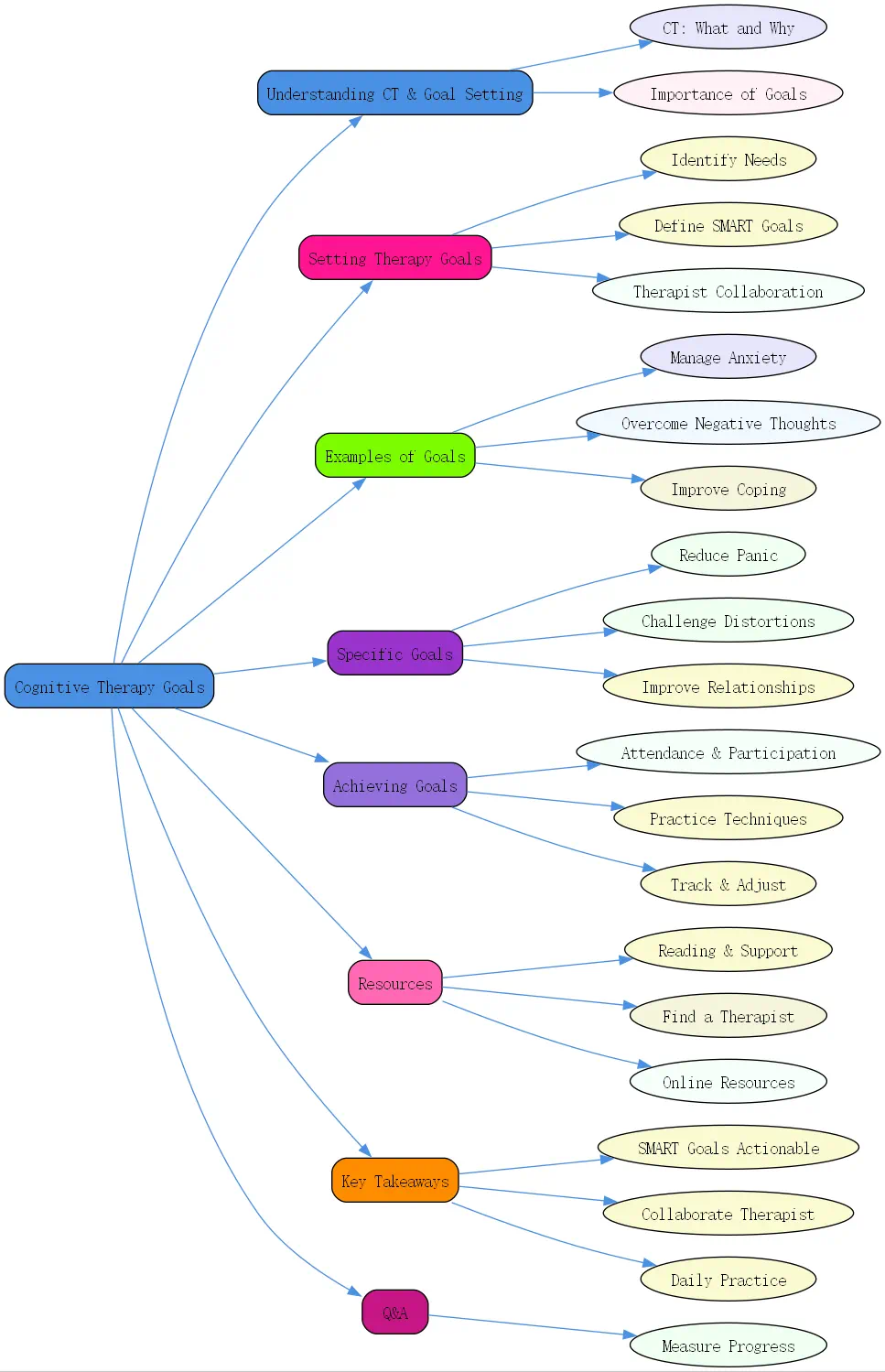Cognitive Therapy Goals: A Comprehensive Guide

Cognitive therapy has become a cornerstone of mental health treatment for those struggling with anxiety, depression, and other emotional challenges. Setting well-defined therapy goals is a critical element in ensuring this approach’s success, as it empowers individuals to take control of their mental well-being. With BrainTalking’s expert insights, this guide will help you understand how to set therapy goals that are effective, achievable, and transformative.
Understanding Cognitive Therapy and Goal Setting
What is Cognitive Therapy (CT)?
Cognitive therapy, often referred to as CT, is a form of psychotherapy designed to identify and modify distorted thinking patterns that lead to negative emotions and behaviors. Introduced by psychiatrist Dr. Aaron T. Beck, CT is particularly effective for managing problems such as anxiety, depression, and stress. By focusing on thought patterns, cognitive therapy helps individuals develop healthier perspectives while building emotional resilience over time.
Why Are Cognitive Therapy Goals Important?
Goals act as a guiding compass in therapy, providing direction and measurable outcomes. When navigating emotional difficulties like stress or depression, setting clear cognitive therapy goals allows individuals to focus on improving specific aspects of their emotional health. Whether your aim is to reduce panic attacks or improve self-esteem, structured goals ensure therapy sessions are purposeful and progress-oriented.

The Role of Goal Setting in Effective Therapy
Goal setting is a collaborative process between you and your therapist. It establishes a sense of accountability and empowers you to actively participate in your growth journey. For instance, a person undergoing depression therapy might set goals to counter negative thought patterns and rebuild their confidence. Without clearly defined goals, therapy can lack direction—making progress harder to track.
How to Set Therapy Goals: A Step-by-Step Approach
Identifying Personal Challenges and Needs
To create effective cognitive therapy goals, the first step is identifying what you hope to achieve. Are you looking to manage stress better? Perhaps you’re seeking to overcome anxiety or improve your relationships. Reflect on your personal challenges, triggers, and desired outcomes to set a strong foundation for your therapy journey.
Defining SMART Goals
One proven framework for setting therapy goals is the SMART (Specific, Measurable, Achievable, Relevant, Time-bound) method:
- Specific: Define the goal clearly. For example, “”reduce work-related anxiety”” is more actionable than “”feel less stressed.””
- Measurable: Establish metrics to monitor progress, such as tracking weekly reductions in anxiety symptoms.
- Achievable: Set realistic targets that align with your capacity and resources.
- Relevant: Make sure the goal aligns with your overall mental wellness objectives.
- Time-bound: Assign deadlines or time frames to create urgency and motivation.
With SMART goals, individuals can focus effort on measurable outcomes, avoiding vague ambitions that lack clarity.
Collaborating with Your Therapist
Effective cognitive therapy requires teamwork. Your therapist plays an integral role by helping you set achievable goals based on their expertise and your unique needs. For example, while undergoing therapy for social anxiety, your therapist might encourage goal-setting around exposure exercises or cognitive restructuring techniques. Consistent collaboration ensures that therapy goals remain relevant and adaptable as progress is made.
Examples of Goals for Cognitive Therapy
Managing Anxiety and Stress
Anxiety and stress are common challenges addressed through cognitive therapy. Goals to set in therapy may include reducing the frequency of panic attacks, developing relaxation techniques, or learning how to reframe anxious thoughts.
Overcoming Negative Thought Patterns
A crucial focus in cognitive therapy is challenging distorted thought processes, such as black-and-white thinking or catastrophizing. Therapy aims to replace these patterns with balanced, constructive alternatives.
Improving Coping Mechanisms
Building robust coping skills is a key therapy goal, especially for individuals struggling with overwhelming emotions. Techniques such as mindfulness exercises and guided breathing can foster resilience and emotional regulation.
Enhancing Self-Esteem and Confidence
For many undergoing cognitive therapy, improving self-esteem and confidence is a pivotal objective. This involves shifting self-perception from overly critical to self-compassionate, enabling individuals to feel empowered in their personal and professional lives.

Specific Cognitive Therapy Goals Explained
Reducing Panic Attacks and Anxiety Symptoms
Managing anxiety often involves targeting specific symptoms like panic attacks, intrusive thoughts, or avoidance behaviors. For example, using the DARE method—a therapeutic approach highlighted by author Barry McDonagh—individuals can learn how to diffuse anxiety and confront fears effectively.
Challenging and Replacing Cognitive Distortions
Cognitive therapy encourages patients to identify and challenge common distortions, such as:
- “”All-or-nothing thinking”” (believing success or failure are your only options).
- “”Overgeneralizing”” (drawing negative conclusions from isolated events).
Replacing these distortions with healthier perspectives is central to achieving lasting emotional change.
Developing Healthier Relationship Patterns
Interpersonal relationships often affect mental health, making this a therapy goal for many. Cognitive therapy offers tools to identify unhealthy patterns, such as co-dependence or avoidance, and foster healthier communication and emotional intimacy.
Improving Emotional Regulation
Struggling to control emotional responses is common among those dealing with anxiety or depression. Cognitive therapy promotes emotional regulation by teaching techniques, such as mindfulness and cognitive reframing, to navigate challenging emotions with greater ease.
Practical Tips for Achieving Your Cognitive Therapy Goals
Regular Attendance and Active Participation
Consistency is the cornerstone of progress in therapy. Regularly attending sessions and actively engaging in exercises strengthen your commitment to achieving goals.
Consistent Practice of Techniques Outside of Sessions
Therapy doesn’t end when you leave the office. Implementing learned techniques—such as mindfulness, journaling, or thought restructuring—into daily life is vital for sustained improvement.
Tracking Progress and Adjusting Goals as Needed
Keep a journal or use therapy apps to track progress on your cognitive therapy goals. If certain goals feel too ambitious or irrelevant over time, discuss adjustments with your therapist to ensure alignment with your evolving needs.
Resources for Further Understanding and Support
Recommended Reading on Cognitive Therapy and Anxiety
Books such as Feeling Good: The New Mood Therapy by Dr. David Burns and The Anxiety Solution by Chloe Brotheridge offer powerful tools for managing anxiety and cognitive distortions. Reading materials can provide complementary insights alongside therapy sessions.
Finding a Qualified Cognitive Therapist

Seek therapists with certifications in CT or CBT (Cognitive Behavioral Therapy). Many platforms, such as BrainTalking’s directory, connect individuals with licensed professionals skilled in treating anxiety and depression.
Online Resources and Support Groups
Engaging in online forums or support groups can enhance the sense of community and accountability. Consider resources related to depression therapy for additional support and tools.
Takeaways for Improved Therapy Goal Setting
- Use SMART criteria to create actionable, realistic therapy goals.
- Collaborate with your therapist for guidance and tailored strategies.
- Incorporate daily practices to reinforce progress and emotional resilience.
By following these steps, you’ll be well-equipped to achieve your cognitive therapy goals and make meaningful changes to your emotional well-being.
Q&A Section
Q: How do I measure progress in therapy when working on complex mental health issues? A: Measuring progress depends on the specific challenges you’re addressing. Start by identifying measurable milestones, such as reductions in anxiety symptoms or improved coping skills. Use journals, self-assessment tools, or apps to track your emotional state daily. Additionally, set regular check-ins with your therapist to review progress and adjust goals as needed. Remember, progress isn’t always linear—small but consistent improvements are still significant.




